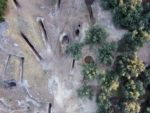 Two intact Bronze Age tombs have been discovered in Aidonia cemetery near Nemea in Greece’s Peloponnese peninsula. Both chamber tombs date to the late Mycenaean period (1400-1200 B.C.) and were found complete with human remains and grave goods.
Two intact Bronze Age tombs have been discovered in Aidonia cemetery near Nemea in Greece’s Peloponnese peninsula. Both chamber tombs date to the late Mycenaean period (1400-1200 B.C.) and were found complete with human remains and grave goods.
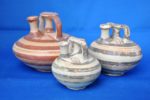 The Aidonia cemetery contains rock-cut chamber graves dating to the Mycenaean era (17th-12th century B.C.). They are of consistent design, each made of three sections: a road or pathway leading to an entrance leading to the burial chamber. The early Mycenaean tombs held richer and more extensive grave goods — jewelry, gold, weapons, luxury ceramics — while the late period chambers had more modest offerings. The newly-discovered tombs contained mainly pottery — figurines, clay vessels, false amphorae, basins — and smaller objects like buttons.
The Aidonia cemetery contains rock-cut chamber graves dating to the Mycenaean era (17th-12th century B.C.). They are of consistent design, each made of three sections: a road or pathway leading to an entrance leading to the burial chamber. The early Mycenaean tombs held richer and more extensive grave goods — jewelry, gold, weapons, luxury ceramics — while the late period chambers had more modest offerings. The newly-discovered tombs contained mainly pottery — figurines, clay vessels, false amphorae, basins — and smaller objects like buttons.
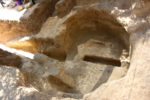 The tombs were reused over the centuries, with the primary (original) burials followed by secondary ones. One of the newly-discovered tombs contained two primary burials and 14 secondary ones. The other tomb contained three primary burials only and was not reused due to the entrance having been blocked by the collapse of the roof soon after its construction. As with the older intact tomb discovered last year, that collapse kept it from being reused and thousands of year later saved it from looters by sealing off and obscuring the entrance.
The tombs were reused over the centuries, with the primary (original) burials followed by secondary ones. One of the newly-discovered tombs contained two primary burials and 14 secondary ones. The other tomb contained three primary burials only and was not reused due to the entrance having been blocked by the collapse of the roof soon after its construction. As with the older intact tomb discovered last year, that collapse kept it from being reused and thousands of year later saved it from looters by sealing off and obscuring the entrance.
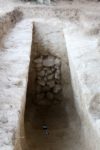 The Mycenaean-era cemetery was discovered not by archaeologists but by looters in 1976. They plundered its ancient grave goods with shameless brutality for two years, with rival tomb raiders getting into literal shootouts at the site until the country put armed guards on the site in 1978 and the first official excavation began. The 1978-1980 and 1986 excavations unearthed 20 tombs, 18 of which had been looted.
The Mycenaean-era cemetery was discovered not by archaeologists but by looters in 1976. They plundered its ancient grave goods with shameless brutality for two years, with rival tomb raiders getting into literal shootouts at the site until the country put armed guards on the site in 1978 and the first official excavation began. The 1978-1980 and 1986 excavations unearthed 20 tombs, 18 of which had been looted.
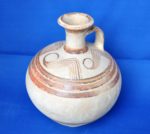 While the pitched battles and overt despoiling of the cemetery ended when the government took over, the looting never did entirely stop. In 2016, the Corinthian Ephorate of Antiquities launched a new excavation program by an international team of researchers to systematically explore the site. The team discovered a new cluster of tombs, most of which had been pillaged, likely in the early 2000s.
While the pitched battles and overt despoiling of the cemetery ended when the government took over, the looting never did entirely stop. In 2016, the Corinthian Ephorate of Antiquities launched a new excavation program by an international team of researchers to systematically explore the site. The team discovered a new cluster of tombs, most of which had been pillaged, likely in the early 2000s.
Those ‘paths to the chamber tombs’ are referred to as ‘Dromoi’. Mainly, the Mycenaean cemetery in Αηδόνια is only 25km away from Mycenae itself and is identified with Araithyrea (Ἀραιθυρέα).
It is mentioned by Homer in the Catalogue of Ships in the Iliad, in Bk.II:
—–
Οἳ δὲ Μυκήνας εἶχον ἐϋκτίμενον πτολίεθρον
ἀφνειόν τε Κόρινθον ἐϋκτιμένας τε Κλεωνάς, [570]
Ὀρνειάς τ᾽ ἐνέμοντο Ἀραιθυρέην τ᾽ ἐρατεινὴν
καὶ Σικυῶν᾽, ὅθ᾽ ἄρ᾽ Ἄδρηστος πρῶτ᾽ ἐμβασίλευεν,
οἵ θ᾽ Ὑπερησίην τε καὶ αἰπεινὴν Γονόεσσαν
Πελλήνην τ᾽ εἶχον ἠδ᾽ Αἴγιον ἀμφενέμοντο
Αἰγιαλόν τ᾽ ἀνὰ πάντα καὶ ἀμφ᾽ Ἑλίκην εὐρεῖαν, [575]
τῶν ἑκατὸν νηῶν ἦρχε κρείων Ἀγαμέμνων
Ἀτρεΐδης· [ἅμα τῷ γε πολὺ πλεῖστοι καὶ ἄριστοι]
—–
(“And they that held Mycenae, the well-built citadel, and wealthy Corinth, and well-built Cleonae, and dwelt in Orneiae and lovely Araethyrea and Sicyon, wherein at the first Adrastus was king; and they that held Hyperesia and steep Gonoessa and Pellene, and that dwelt about Aegium and throughout all Aegialus, and about broad Helice,—of these was the son of (*)Atreus, lord Agamemnon, captain, with a hundred ships. With him followed most people by far and goodliest; and among them he himself did on his gleaming bronze, a king all-glorious, and was pre-eminent among all the warriors, for that he was noblest, and led a people far the most in number.”)
—
[There is a really massive beehive tomb with a HUGE(!) Dromos on Panagitsa Hill at Mycenae, dubbed as “Treasury of Atreus” 😉 ]
—
In April 1993, an important collection of valuable objects from the Late Bronze Age Aegean, of Minoan-Mycenaean style, was put up for auction at the Michael Ward Gallery in New York. The collection comprised two gold signet rings, two more finger rings of gold and one of electrum, three sealstones of amethyst, agate and steatite, gold ornaments and numerous beads in various shapes of gold, semiprecious stones, amber, faience and glass. Most of the objects can be dated to ca. 1500-1400 BC. A ring of electrum with a bezel in the shape of a squatting monkey (cat. no. 6) and a scaraboid amethyst sealstone with a griffin (cat. no. 5) are probably Minoan works of the 16th century BC. Some beads made from semiprecious stones, faience and glass, probably belong to the 14th-13th centuries BC. The items have been published in the auction catalogue with texts by J.H. Betts and high-quality pictures (New York 1993).
…and the rest is History :confused: